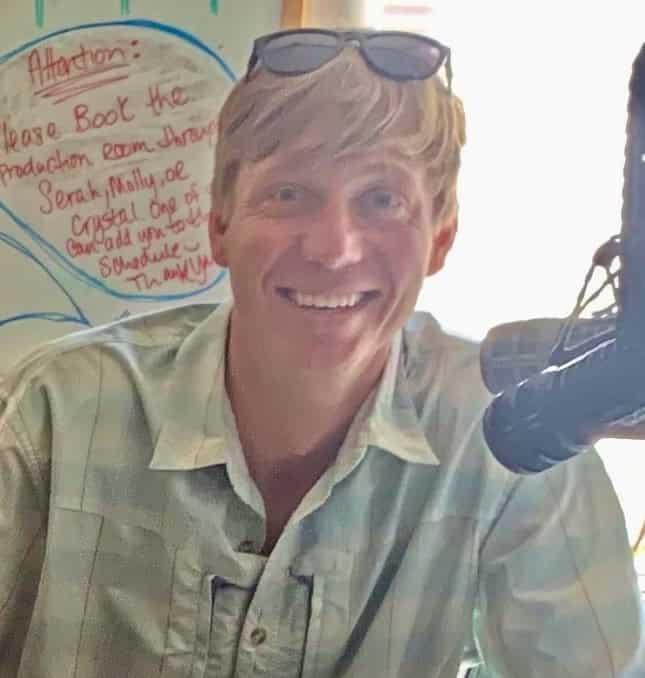Some information may be outdated.
Southeastern Utah attracts scientists from various fields to study the amazing and unique natural features of the region. Science Moab loves our opportunity to speak to these scientists and bring you updates and insights from recent conversations. Here, we highlight interesting talks with behavioral ecologist Sean Mahoney, Diné river guide and community organizer Colleen Cooley, and paleontologist John Hankla.

Science Moab: What are willow flycatchers known for? Where can we find them?
Sean Mahoney: Willow flycatchers are famous for being very difficult to identify in the field by sight. They’re gray and green, kind of drab-looking, with some yellowish coloration. If you talk to a birder, they’ll often talk about how challenging it is to identify these birds. Oftentimes, people are hoping the birds will sing, because flycatchers have very distinct songs.
Flycatchers are “riparian obligates,” so they nest exclusively along rivers. On the Colorado Plateau they’re common along the Virgin River, particularly around St. George. We think that the rivers in Moab are a really important stopover habitat for them.
Science Moab: How did your research impact the confirmation of the southwestern subspecies of willow flycatcher?
Mahoney: We argued that because song is ingrained in the southwestern willow flycatcher’s DNA, the subspecies has these unique alleles that cause it to sing a different type of song than the other three subspecies of willow flycatchers. The whole idea of the Endangered Species Act is to conserve genetic diversity—this was another argument that this group of birds has a unique genetic makeup, and because of that, warrants protection under the Endangered Species Act.
We also found that the birds recognized their own subspecies’ song. The takeaway is that song is an important signal in identifying subspecies, and that individual birds can recognize those song differences.
Our response paper, we’re proud to say, helped decide that the southwestern willow flycatcher would remain on the endangered species list. We were very, very proud of that work. But when we finished that project, we realized that unfortunately, these sorts of attacks on endangered species throughout the United States are going to continue. We really wanted to get ahead and strengthen as best we could the argument for protection of southwestern populations.

Science Moab: What would you like to see moving forward for other women and Native people guiding in these places that are ancestral lands?
Colleen Cooley: Well, maybe there’s a connection there that they can take away. I can’t speak for all guiding companies, but I know this space is still mostly male-dominated. But I think in the last few years, there’s been a shift to hire more women and more Native guides. I definitely want to see more women and Native and Indigenous guides on the rivers and on the landscape as leaders.
I also think that it’s important for companies to provide a support system for new Native guides. If I’m coming in as a new guide, I may have trouble connecting with other guides socially or culturally because they might not understand why I pray with corn pollen before I go on a river trip, or they may not understand that I’m not allowed to go into an ancestral dwelling. They may not know how much I carry with me in terms of my responsibilities back at home.
Science Moab: Is there anything else you would like to see in general for the protection and care of this region and the people living here?
Cooley: I think the main takeaway is to acknowledge, incorporate, listen to, and uplift the voices, perspectives, and knowledge of Indigenous peoples.

Science Moab: What do you find most challenging about paleontology?
John Hankla: Paleontology is the study of ancient life. If you really break that down, we’re less interested in skeletons and more interested in the living animals. Some of the questions we have about living animals are quite complicated, and really tough to deduce just from the leftover hard parts.
For example, take your favorite animal and remove all the muscles and tendons and skin and behavior, and most of its ecology. Put just the skeleton in a paper sack, and beat it up with a hammer. Then take about 30% of that and spread it over an acre of land. That’s the evidence we’re using to deduce the life of that animal.
In this country, fossils belong to the owner of the land where they’re found. For that reason, most paleontologists that I know are die-hard public land supporters. In these rocks are the fossil data that basically hold up our understanding of how the world was made, how life on Earth evolved, and how it became the world we know now. This is our collective natural history, belonging to the collective human race. One of the keys to making sure we have enough data to understand the world is ensuring the sources of that data are protected.
Science Moab is a nonprofit dedicated to engaging community members and visitors with the science happening in Southeast Utah and the Colorado Plateau. To learn more and listen to the rest of these interviews, visit www.sciencemoab.org/radio.
Appreciate the coverage? Help keep local news alive.
Chip in to support the Moab Sun News.





